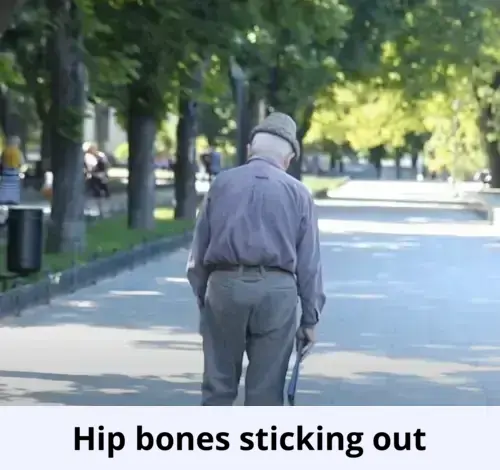Have you ever noticed your hip bones sticking out more prominently on one side or both sides? Perhaps you’ve even felt a bit self-conscious about it or wondered if it’s normal. The truth is, while it’s not uncommon to have asymmetrical hip bones, there are certain causes that may be contributing to this issue.
We’ll explore what those causes are and what you can do to address them. So, let’s dig in and find out if your hip bones are trying to tell you something!
What is the medical term for hip bones that stick out
The medical term for hip bones that stick out on one side or both sides is femoroacetabular impingement (FAI). This condition occurs when extra bone grows along the bones that form the hip joint, resulting in irregular shaped bones that rub against each other during movement. FAI can lead to damage in the joint, causing pain and limiting activity.
The hip joint is a ball-and-socket joint consisting of the acetabulum (part of the large pelvis bone) and the femoral head (upper end of the thighbone). In FAI, bone spurs develop around the femoral head and/or along the acetabulum, causing abnormal contact between the hip bones and preventing them from moving smoothly during activity.
FAI can occur due to deformities in hip bone development during childhood. Symptoms include pain in the groin area, dull aches, and sharp stabbing pain while turning, twisting, or squatting.
Over-the-counter anti-inflammatory medicines and modification of activities can provide relief, but seeking medical treatment is recommended for proper diagnosis and treatment options.
Causes of hip bones that sticking out
Hip bones sticking out on one side or both sides can be caused by a variety of conditions. Uneven hips might be due to scoliosis, a curvature of the spine, or a functional or structural leg length discrepancy.
Poor posture and muscle imbalances can also lead to one hip appearing longer or shorter than the other. Meanwhile, hip impingement can cause pain and decreased range of motion in the hip, especially when walking or flexing. It occurs when there’s a deformity of the ball at the top of the femur and/or the socket.
Other conditions that may lead to hip impingement include Legg-Calve-Perthes disease, slipped capital femoral epiphysis, and coxa vara.
Developmental Issues and Posture
Developmental issues and poor posture are some of the most common causes of uneven hips. Scoliosis, a sideways S- or C-shaped curve of the spine, may lead to uneven hips in some individuals.
Girls are more likely to develop scoliosis than boys, and the condition may worsen over time if left untreated.
Another cause of uneven hips is a functional leg length discrepancy, which is often caused by poor posture, muscle imbalances, or staying in one position for long periods.
On the other hand, structural leg length discrepancy results from differences in bone length and may be caused by an injury, a congenital abnormality, or a growth condition.
Functional and Structural Leg Length Discrepancy
Functional length discrepancy occurs when one leg appears longer than the other, due to muscle tension and imbalances in strength caused by poor posture or leaning on one side for an extended period.
Structural leg length discrepancy, on the other hand, is a physical difference in leg length caused by issues such as missing or shorter bone, congenital abnormalities, and growth plate injuries. This type of discrepancy can lead to problems such as back and hip pain, difficulty walking, scoliosis, and even emotional distress.
Treatment varies depending on the cause and severity, ranging from monitoring to surgery for more severe cases. It’s essential to seek medical attention if you experience any symptoms or notice hip bones sticking out unevenly, as prompt diagnosis and treatment can prevent further complications.
Symptoms of Uneven Hips
1. General low back pain
2. Pain in the hip and buttock area that worsens with walking
3. Pain in the hip and low back after standing for long periods
4. Unbalanced gait or walking
5. Achy feeling in the lower back or hip while lying down
6. Pain that travels down the thigh to the knee
7. Pain in and around the groin area
8. Inability to stand in place or walk
9. Poor spine alignment
10. Uneven shoulders, hips or waistline
It’s essential to understand that having uneven hips can cause pain and discomfort that can progress to more severe complications if left untreated. A physical therapist can evaluate your posture and alignment and provide treatment to help realign your hips and pelvis. Seeking professional help is the best way to correctly diagnose and treat the cause of uneven hips. Remember, early intervention is always best to ensure a pain-free, functional life.
Effects of Uneven Hips on Posture and Appearance
Uneven hips can have significant effects on a person’s posture and appearance. When hips are not aligned, the pelvis and spine are also affected, leading to an anterior pelvic tilt and changes in biomechanics.
People with uneven hips may have a shoulder that sits higher on the side of the lower hip, making their shoulders appear uneven. They may also have a shoulder blade that sticks out or a curved spine that can cause rib cage protrusions. Additionally, uneven hips can cause emotional distress and affect how clothing fits, leading to decreased self-confidence.
Treatment Options for Uneven Hips
Treatment options for uneven hips depend on the underlying cause of the condition. In some cases, mild cases may only need to be monitored, while more severe cases may require surgery.
Physical therapy can also be helpful in improving muscle imbalances and correcting posture. A physical therapist can develop an exercise program to target specific muscle groups that help realign the hips. They may also use manual therapy techniques to help improve joint mobility and reduce pain.
Other treatments may include wearing orthotics or shoe inserts to improve leg length discrepancies. It is best to consult with a healthcare professional to determine the most appropriate treatment plan for uneven hips.
Early diagnosis and treatment can prevent complications and improve overall quality of life.
About the Author
Reyus Mammadli is the author of this health blog since 2008. With a background in medical and biotechnical devices, he has over 15 years of experience working with medical literature and expert guidelines from WHO, CDC, Mayo Clinic, and others. His goal is to present clear, accurate health information for everyday readers — not as a substitute for medical advice.







